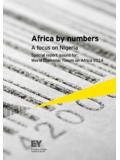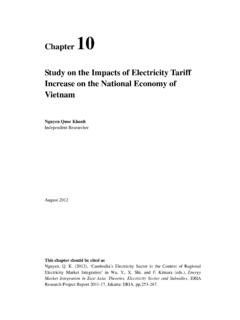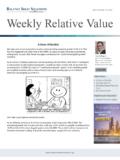Transcription of EXPORT PROCESSING ZONES PROGRAM ANNUAL …
1 EXPORT PROCESSING ZONES PROGRAM . ANNUAL performance report , 2012. Table of Contents Executive Summary .. 2..2. National and International Scene .. 4. performance by key sectors .. 5. Outlook .. 10. EPZ performance for the year 2012 .. 10. Project Approvals .. 12. Status on gazetted ZONES .. 13. performance of operational 14. ZONES contribution to EPZ objectives .. 19. Sector performance .. 20. of EPZ enterprises .. 23. Investment by operating EPZ firms .. 24. Impact of African Growth Opportunity Act .. 24. performance of selected Sub Sahara African AGOA accredited countries.. 27. Significance of EPZ to the economy .. 30. Regional performance .. 32. Destination of Exports .. 34. Employment and wages .. 35. Training of local workers and transfer of technology .. 38. Constraints reported by EPZ enterprises .. 39. Challenges facing the PROGRAM .
2 39. Way forward/required support .. 42. 1. Executive Summary The performance of the EPZ PROGRAM in the year 2012 showed an upward trend with respect to major indicators in the face of adverse global economic environment especially in the Eurozone which had a ripple effect to the rest of the world as outlined in the subsequent part of this report . The adverse impact brought about by unfavourable local business environment which was characterized by high cost of production especially power tariffs that remains a challenge towards realization of the EPZ PROGRAM potential. This was exacerbated by competition from more efficient Asian apparel/garment exporting countries like China, India, Bangladesh, Cambodia and Vietnam among others. Another challenge to the PROGRAM is the enlargement of the domestic market to include East Africa Community (EAC) which means that EPZ.
3 Firms have to sell only 20% of their ANNUAL production into the domestic market. This has adversely affected enterprise targeting EAC market. EPZ PROGRAM recorded growth in principal indicators like exports, total sales (turnover), capital investment, expenditure on local goods &. services and average monthly wage with respect to local employment among others. For instance, exports grew by , total sales while expenditure on local goods & services rose by in the year 2012. Another recent development within the zone is the implementation of EXPORT Business Accelerator (EBA) Incubator, in which it has improved venture into the EXPORT business by small scale indigenous enterprises (SMEs). With the implementation of this project, local ownership of EPZ. companies has risen from in 2010 to in 2012. Introduction The EPZ PROGRAM experienced growth in the year 2012 as evidenced by performance of key indicators compared to the previous year.
4 During the year under review there were activities which took place both at institutional and national level which in one way or another has a bearing to overall development of the country and PROGRAM . At the national level was the ongoing implementation of the New Constitution which involved putting the required legal framework to lay 2. foundation for appropriate institutions which would spur socio economic development taking into account the delvoved system of government. The year 2012 was the fifth in the implementation of the First Medium Term Plan (MTP) 2008 2012. It is the foundation for the first phase of implementing Vision 2030; Kenya's new, long term policy blue overall objective is to realize a higher and sustainable growth of the economy in a more equitable environment, accompanied by increased employment opportunities.
5 Plans were underway for the preparation of the second MTP covering the period 2013 2017. MTP focuses on improving & modernizing country's infrastructure and increasing of manufacturing & industry in Gross Domestic Product (GDP). as well as manufactured exports in total exports among others. It also aims at reducing the number of people living below poverty line from 46% to 28% by creating million additional employment opportunities within the MTP period. EPZ PROGRAM has contributed towards realization of this objective. At the institutional level, ongoing implementation of Strategic Plan covering the period 2009-2013 on course that laid emphasis on transformation of EPZ to Special Economic ZONES (SEZ). It is expected that this objective of SEZ would be realized sooner than later for the benefits to be enjoyed by the EPZ investors even as initiative towards successor strategic plan is under consideration.
6 The EPZ PROGRAM has made her share of contribution to Kenya's economy especially employment creation, attraction of new investments and value addition in terms of local resource utilization (domestic expenditure) among others. This report provides insight to the national and international economic environment borrowing highlights from Economic Survey 2013, EPZ. performance analysis under various indicators, impact of African Growth Opportunity Act (AGOA), constraints/challenges, set & actual targets for the year 2012 including projection for 2013, and finally the conclusion. 3. National and International Scene According to Economic Survey 2013, the national/ domestic economy posted a real Gross Domestic Product (GDP) growth of in 2012. compared to a revised growth of in 2011 (chart 1). Macro economic variables remained generally stable, although a surge in inflation during 2011 prompted tightening of monetary policy stance up to mid 2012.
7 Activities accelerated in Agriculture, Whosale & retail trade and transport & communication which, respectively, accounted for and to overall GDP. All sectors of the economy recorded positive growth, though expansions were moderate. Price stability was the main focus of monetary policy in 2012. The Central Bank Rate (CBR) was maintained at level up to June 2012. and gradually eased the tightening to in November 2012 as the pressure on inflation reduced. Inflation eased from ANNUAL average of in 2011 to in 2012, partly reflecting better harvests occasioned by favourable weather conditions and tightening of monetary policy during the first half of 2012. At the international scene, the world real GDP, grew by in 2012. compared to a growth of in 2011. The reduced growth led to slowed world trade and uncertainty in advance economies which also affected performance in emerging market and developing economies.
8 Growth in the Organization of Economic Cooperation and Development (OECD) economies slowed by in 2012 compared to in 2011. The Euro Area's real GDP recorded a decline of in 2012 compared to a growth of in 2011. Sub Suharan Africa's (SSA) real GDP. expanded marginally by in 2012 compared to in 2011. The East Africa Community's (EAC) real GDP remained constant at in both 2012 and 2011. This was as a result of pressure on food and fuel prices easing up following a surge in 2011. 4. Chart 1: Real GDP growth rate (%), 2008 to 2012. Source: Economic survey, 2013. performance by key sectors of the economy Agriculture Economic Survey 2013 indicated that agricultural sector recorded mixed performance in 2012. Agriculture value added at constant prices increased by in 2012 compared to a growth in 2011. Coffee production increased by 35% from thousand tonnes in 2010/11 crop year to thousand tonnes in 2011/12.
9 Area under coffee bushes remained at 2011 levels in 2012. The high production was attributed to favourable weather conditions experienced in the coffee growing areas and maturing of high quality coffee varieties. The average yield per hectare for estates increased from 417kg/ha to 553kg/ha while that for cooperatives improved from 163kg/ha in 2011 to 207 kg/ha in 2012. 5. The area under tea increased from thousand hectares in 2011 to thousand hectares in , tea production decreased by from thousand tonnes in 2011 to thousand tonnes in 2012. This is attributed to a decline in production from estates. As a result, the share of tea produced by estates reduced from in 2011 to in 2012. Although production of small holder recorded a marginal drop, its share rose from in 2011 to in 2012. The low yield was a result of frost attack in some parts of tea growing regions in addition to the dry spell experienced in the first quarter of 2012.
10 The horticulture subsector registered a depressed performance for the second consecutive year as the quantity of fresh produce contracted by in 2012. The total quantity of exported flowers, fruits and vegetables decreased from thousand tonnes in 2011 to thousand tonnes in 2012. However, the total value of fesh horticultural exports increased marginally in the same period, rising to Kshs billion in 2012 from Kshs billion in 2011. The volume of cut flowers and vegetables went down by and ; respectively in 2012 while that of exported fruits rose by Cut flowers remained the leading horticultural commodity exported to foreign markets, accounting for more than half of the total volume exported in 2012. The value of flowers exported increased by Kshs billion above the 2011 level, adequately compensating for the decrease in the value of vegetables.





